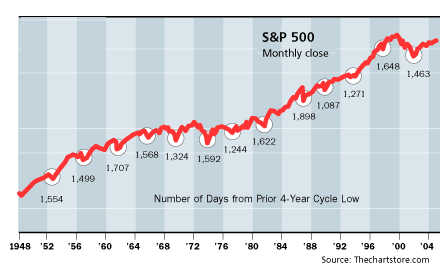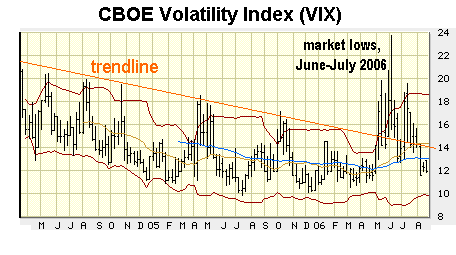

|
| weblog/wEssays archives | home | |
|
Protecting Capital I (September 5, 2006) Reader Adam T. sent in this question about how best to protect one's capital: I enjoy your weblog & wEssays on a weekly basis. I find them some of the most well though-out, well articulated sources of insight on the Web. With the flattery out of the way, I’d like to know if any of your past writings have addressed what to do with investment capital in advance of the economic pain you and many of us think the world will experience quite soon (as housing prices correct, consumer spending drops, energy prices remain high/increase, bad debt costs hit financial institutions, the dollar weakens, costs of war remain high, etc).This question is so big that I am making it the theme of this week's entries. I am going to address it from this angle: if an investor can guess/ascertain the future course of any one of the following--the U.S. stock market, commodities, the dollar and inflation/bonds, then that investor will probably make better decisions than those who guess wrong on all fronts. Important disclosure: this is not investment advice, either intended or implied. This is a discussion of economic and financial conditions, not recommendations for the buying and selling of any security in any market. The posting of any link here does not constitute a recommendation of the views of the author of any such link. If you seek investment advice, you will not find it here; please go elsewhere for investment advice. I am sincere about this: the idea here is not to provide investment advice, but to offer a discussion which will hopefully encourage readers to pursue their own research and thinking. OK, let's get started with the U.S. stock market. What forces might be at play in the near future? One might be "the 4-year cycle," a historical pattern in which the U.S. stock market tends to hit a low in the election years between Presidential elections: 2002, 1998, 1994, 1990, 1986, etc. Here is a chart to consider: 
Explanations for this pattern vary, of course; one popular one notes that the first two years of a President's term are typically ones of public spending largesse. Then, as the unfortunate side effects of such largesse become apparent--for instance, inflation-- and/or the public coffers run dry, then spending declines, slowing the economy just as the mid-term elections come round. There may not be any single causal connection between these low points; it may be more or less random. After all, the 1986 bottom was seemingly delayed a year until 1987; the 1994 low was more of a flat spot than a downward spike, while the October 1998 mini-crash was caused by unexpected financial crises--the Russian bond default and the meltdown of Long Term Capital Management. The 2002 low is generally viewed as a typical post-bubble or business-cycle low. So exactly why might the market follow this pattern and hit a multi-year low in October 2006? No one knows. Perhaps the 4-year low will be delayed until 2007, or perhaps it will skipped entirely as a new Bull Market tears upward. But just as a point of discussion, I would posit two possible triggers for the pattern to successfully repeat this year: 1) An "unexpected" external financial shock, or 2) a realization that the housing bubble's popping guarantees a recession in early 2007. The cliche is that the market is a discounting mechanism, that it continuously and accurately "discounts" news good and bad. This is of course false; the market ignores bad news when it's running euphorically higher, and ignores good news when it's dropping in full-blown panic selling. There are various measures of implied risk in the market, one popular one (though limited by its short 30-day window) is the VIX, which measures implied volatility via options. It works like this: if traders are scared of a big decline, they will hedge their long positions by buying lots of puts, which increase in value as the market falls. If nobody's buying puts, then that suggests there is no fear in the market. If traders are extremely bullish, they will load up on calls, which rise in value as the market climbs. If there is little activity in options on either side, this suggests complacency. Judging by the long period of low volatility expressed by the VIX, complacency reigns supreme. Note that the VIX operates in a negative correlation to the market; when the market is dropping, the VIX rises along with fear/panic. When the market is bullishly rising, the VIX falls to its lows. Here is a chart of the VIX: 
Thus, the VIX spiked up during the recent market lows in Summer, and has since fallen back to its declining trendline. What does this suggest to traders? That market participants sense very little risk in the near future. If they did sense any risk, they'd be snapping up puts to protect their portfolios. Given the many potential risks of financial disruption present in today's global economy, this may well be a classic mis-appraisal of risk. If--and I repeat, if--one of these risks flared up, the market is set up to be "surprised," as few traders are hedged against such a disruption. The biggest panics tend to develop in just such complacent times, when risks have been "discounted" and the market assumes clear sailing ahead. When fear (and thus the VIX) are sky-high, that spike tends to mark market bottoms. The VIX can also be interpreted as indicating the market discounts any chance of recession. If market players feared a recession would deflate the economy in six months, they'd be busily protecting their long positions with puts, or simply liquidating positions. Some players suspect that many traders are indeed liquidating their positions, as evidenced by the declining COT (Commitment of Traders) numbers. At least one professional trader believes the way to make money (or protect capital, take your pick) is to avoid trading stocks, and trade only volatility. Note: the following story link does not imply I agree or recommend this strategy; it is here for your information, not as advice. From Barron's: Time to Bet Big on Options. To summarize: if someone concluded that the market was at risk of hitting a multi-year low in October, they might either set stops on their long positions (so that their position would be automatically sold once it fell below a certain price) or buy puts which would rise if the market fell significantly, or both. A cautious person might well just stick with cash and see what happens in October. If nothing untoward occurs, then fine; seasonally, the market tends to rise from November through March (hence the cliche, "sell in May and go away"), so the opportunity to get in on the seasonally strong period would still be available. But we should also be mindful of the contrarian views. The contrarian looks at what the majority of market players expect and then bets against that majority. Since the majority clearly believes in a warm and fuzzy low-risk environment up ahead, the contrarian bets on increased volatility. Why would markets respond against general expectations? There are several ways to explain this mechansim.The ornery one goes like this: the market will always go in whatever direction maximizes pain for the largest number of players. A slightly less ornery view is that when everyone is bullish, there's no money left to buy more stocks; since demand is bound to weaken, then the fact that everyone's bullish is actually bearish. A contrarian might say this: since many market pros expect a big drop as per the 4-year cycle, the market is actually poised to rocket upward. That's ultimately the weakness in any contrarian perspective; you can always dig up some indicator which supports a contarian take on the market. This is why some say the stock market is nothing but "a random walk down Wall Street." For more on the COT, please read these two entries, which include a detailed commentary from reader Harun I. in the Aug. 10 post. As a special bonus, I have (with Harun's permission) posted a thought-provoking essay he recently sent me: Chasing Our Tails? (August 9, 2006) Our Major Export to China: Inflation (August 10, 2006) Harun I.'s commentary Here are some other recent entries on related financial/economic topics: What We Know, What We Can Safely Predict (June 20, 2006) Could We Have Both Deflation and Inflation At the Same Time? (June 5, 2006) Where There Is Ruin, There Is Profit II (July 31, 2006) Housing Dominoes Fall (July 26, 2006) You Can't Have It Both Ways (August 30, 2006) For more on this subject and a wide array of other topics, please visit my weblog. copyright © 2006 Charles Hugh Smith. All rights reserved in all media. I would be honored if you linked this wEssay to your site, or printed a copy for your own use. |
||
| weblog/wEssays | home |